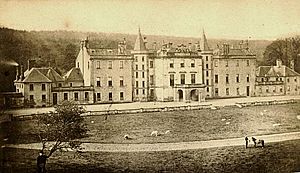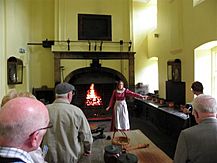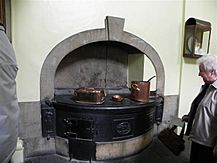Callendar House facts for kids
Quick facts for kids Callendar House |
|
|---|---|
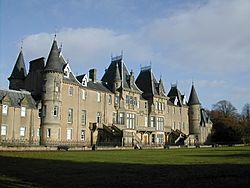
The south façade of Callendar House
|
|
| Location | Callendar Road, Falkirk FK1 1YR, Scotland, United Kingdom |
| Founded | 14th century |
| Built | 1877 |
| Built for | Forbes family |
| Architect | Brown and Wardrop |
| Architectural style(s) | French Renaissance Revival Châteauesque |
|
Listed Building – Category A
|
|
| Official name: Callendar Park, Callendar House | |
| Designated | 21 March 1960 |
| Reference no. | LB31236 |
|
Inventory of Gardens and Designed Landscapes in Scotland
|
|
| Official name: Callendar Park | |
| Criteria | Architectural Archaeological |
| Designated | 31 March 2007 |
| Reference no. | GDL00078 |
| Lua error in Module:Location_map at line 420: attempt to index field 'wikibase' (a nil value). | |
Callendar House is a grand old mansion located in Callendar Park in Falkirk, central Scotland. It looks like a fancy French castle, but it also has parts that look like traditional Scottish buildings. The oldest part of the house is actually a tower from the 1300s!
This amazing house has been around for over 600 years. Many famous people have visited or lived here, including Mary, Queen of Scots, Oliver Cromwell, Bonnie Prince Charlie, and Queen Victoria. Callendar House is the biggest historical building in the area, with a front that is about 91 meters long. It's a very important historical site, and its beautiful gardens are also specially protected.
Contents
A Look Back: The History of Callendar House
Callendar House sits right on the line of the Antonine Wall. This wall was built by the Romans way back in the 2nd century to protect their land in Scotland.
In the 1100s, a family called Callander lived in a place nearby called Thanes Hall. They were important local leaders. Later, in the 1300s, one of them, Sir Patrick Callander, supported a different person for the Scottish throne. Because of this, his lands were taken away.
The Livingston Family's Time
In 1345, the Callander lands were given to Sir William Livingston by King David II. Sir William was married to Christian Callander, who was Sir Patrick's daughter. The Livingston family became very powerful in Scotland over the next few centuries.
- Sir Alexander Livingston was a special helper to the young King James II in the 1440s.
- Later, Alexander, 5th Lord Livingston, looked after Mary, Queen of Scots, when she was a child. The agreement for Mary to marry the French prince was even signed at Callendar House!
- Mary Livingston, Lord Livingston's daughter, was a close friend to Queen Mary.
- Mary, Queen of Scots, and her husband, Lord Darnley, visited Callendar House in 1565 during a stormy time.
Alexander Livingston, 1st Earl of Linlithgow and his wife, Lady Eleanor, were chosen by King James VI & I to raise and educate his daughter, Princess Elizabeth.
The Livingston family became very important, with some members even becoming "Earls." But their time at Callendar House ended suddenly in the 1700s. James Livingston, 5th Earl of Linlithgow, had supported the "Old Pretender" (the son of King James II), who wanted to be king. Because of this, James Livingston had to leave the country, and the Callendar estates were taken away.
The lands were bought by a company, which then rented the house back to the Earl's daughter, Lady Anne Livingston.
On September 14, 1725, Bonnie Prince Charlie stayed at Callendar House. He convinced Lady Anne and her husband to join his cause. Lady Anne welcomed Bonnie Prince Charlie again before the Battle of Falkirk in 1746. After his defeat, Lady Anne's husband was executed for going against the king. Lady Anne stayed at Callendar House until she passed away in 1747. Her son, James Hay, 15th Earl of Erroll, continued to live there until his death.
The Forbes Family Takes Over
In 1783, the Callendar estate was put up for sale. William Forbes, a successful businessman from Aberdeen, bought the house and estate for a huge sum of £100,000. He made many changes to the house, and his son and grandson later added the French-château-style roofs.
When the Union Canal was being planned, William Forbes didn't want it to go through his estate near Callendar House. So, a long tunnel, about 636 meters long, had to be built through Prospect Hill instead. This tunnel is still used today by boats and walkers, and it even has lights!
A special building for pigeons, called a dovecote, was built in the 1850s. The kennels below it were even heated for the dogs!
Callendar House in the 1900s and 2000s
In 1963, Falkirk Burgh Council bought Callendar House and some of its parkland. Since 2011, a group called Falkirk Community Trust has been in charge of managing the house. Most of the estate is still owned by the Callendar Estate company, which is the biggest landowner in Falkirk.
In July 2011, Falkirk Community Trust took over the running of Callendar House.
Callendar House was voted "Favourite Visitor Attraction" by a local radio station, Forth2. Many people visit the house each year, especially since the nearby Falkirk Wheel opened.
Callendar House as a Museum
Callendar House has become a major heritage center. The inside of the house has been beautifully restored to look like it did in the Georgian period. It is now the main museum in the Falkirk area, showing art, history, and what life was like in a grand house.
The house has two amazing rooms, the Pink Room and the Green Room. It also has a fully working Georgian kitchen with a huge open fireplace. Visitors can step back in time and see how people lived and worked centuries ago. Staff in old-fashioned costumes even prepare the same kinds of food that were served at big parties long ago.
There are also permanent exhibitions, like "William Forbes' Falkirk" and "The Antonine Wall." Other galleries show different exhibitions from around the world throughout the year.
The house also has a history research center in its old Victorian library. This is where all of Falkirk's historical records are kept.
Exploring Callendar Park
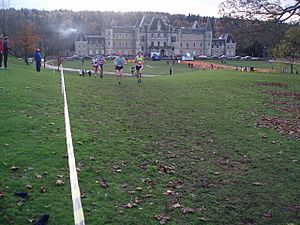
The park around Callendar House is huge and has lots to do! You can find a pitch and putt course, crazy golf, a children's playground, and a boating lake. The ancient Antonine Wall also runs through the park. There's even an art gallery, the Park Gallery, inside Callendar House.
Callendar Estate covers about 2 square kilometers and has lovely woodlands for walks. It's also home to the Forbes family mausoleum, a large, round, Greek-style building where many members of the Forbes family are buried.
Many events happen in the park all year, including a huge annual firework display that attracts over 70,000 people. Other events include a street arts festival called Big in Falkirk and national cross-country running championships. Behind the house is Callander Wood, which has many paths for walking and dog walking.
More to Explore
- List of places in Falkirk council area
- Inventory of Gardens and Designed Landscapes


